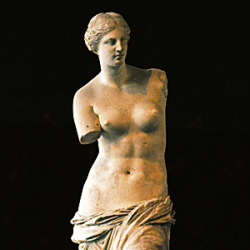Text
Angry Beavers v. Mondrian
In an episode of the Angry Beavers, the titular beavers (that sounds innapropriate) experience hallucinations of some classical art. In this portion of the hallucination, Dagget sees a dancing pickle performing in front of a Mondrian backdrop.
I, for one, agree with the writers. Mondrian paintings do lack a certain panache.
2 notes
·
View notes
Text
Venus in Burns' basement

While plotting some doubtlessly evil scheme, Monty Burns and his loyal assistant Smithers can be seen wandering around the Burns' estate basement. In the background, the sculpture Venus Di Milo stands.
Why isn't she in the Louvre? The Louvre is under the impression she's in the Louvre. How did he get Venus anyway? So many questions and no answers.

3 notes
·
View notes
Text
Springfield's Sistine Chapel
It's strange to imagine a government building like a Post Office adorned with a recreation of one of the most elaborate collection of paintings ever (the Sistine Chapel), but if any town could do it, it'd be Springfield.
It's strange to see a parody like this, because generally the structure will be the same: power coming from the right half being passed on to the weaker left half. In this case, the famous painting by Michelangelo is changed.
Instead of a serene and all-powerful God handing off the gift of life with infinite grace, a struggling postman fights animals and nature to fulfill his duty. Divine beings just pass off life as if it's nothing while mortals are barely able to move around paper.
0 notes
Text
Great Wave off Kanagawa
In a sushi resturant named "The Happy Sumo" in Springfield there is a recreation of the woodblock printing of "Great Wave off Kanagawa" by Hokusai. Certainly not ancient, it was created in 1832, Hokusai seems to be more of a documentarian than an artist. Still, either it is a recreation of a particularly memorable day at sea, or it can be seen as an metaphor for humanity's struggle against nature.
This painting appears during a scene in which Homer tries his very first meal of sushi. He eats and is poisoned by Fugu (blowfish), a legitamately dangerous dish. Is this a clever comment by the writers concerning humans losing a battle to nature? Or is it simply the most easily identifiable Japanese piece of art?
1 note
·
View note
Text
Bart Doodles over History
Apparently, when Emanuel Leutze was commissioned to paint a rendition of George Washington Crossing the Delaware, Leutze didn't consult a history book. If he had, Leutze would have realized he'd painted an anachronistic American flag.
When Bart doodles further historical innaccuracies (like planes and sea monsters) in his textbook featuring this painting, is he making a statement about the inherent faultiness of history texts? Or is he just doodling?
I bet he just digs monsters, but I can't speak for the writers.
0 notes
Text
"Howl of the Unappreciated" by Lisa
During episode 207 "Bart vs. Thanksgiving", Lisa pens her own version of "Howl" after Bart ruins the family's festivities. Coincidently, while Lisa was focusing on Allen Ginsberg, Bart goes off on his own journey of self-discovery a la Jack Kerouac.
Lisa Simpson's version:
I saw the best meals of my generation destroyed by the madness of my brother. My soul carved in slices by spikey-haired demons.
Allen Ginsberg's version:
I saw the best minds of my generation destroyed by madness, starving hysterical naked, dragging themselves through the negro streets at dawn looking for an angry fix, angelheaded hipsters burning for the ancient heavenly connection to the starry dynamo in the machinery of night
2 notes
·
View notes
Text
Maggie as "The Dream"
Maggie appears as the subject of Salvadore Dali's "The Dream." To help the audience get the reference, the animators also included some of Maggie's pacifiers in the place of Dali's characteristic melting clocks even though they aren't found in "The Dream".
3 notes
·
View notes
Text
Bart as "Son of Man"
In this reference, Bart leaves off the bowler hat so his trademark spiked hair is visible. It seems that even though "Son of Man" can be seen as Magritte's statement on the anonymous nature of modern man, Bart can't help but hide his true identity.
2 notes
·
View notes